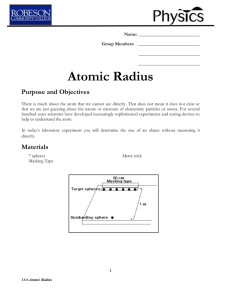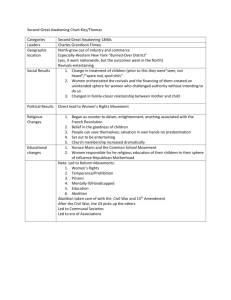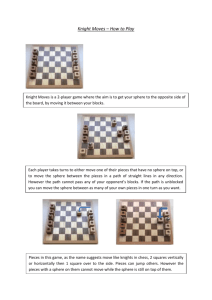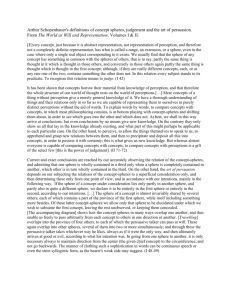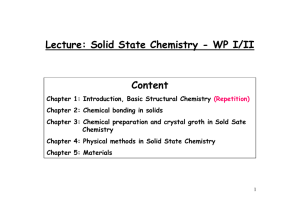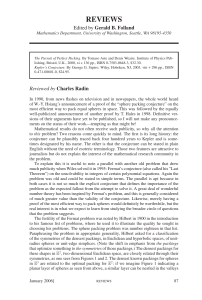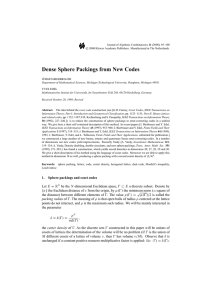FIGURE CAPTIONS
advertisement
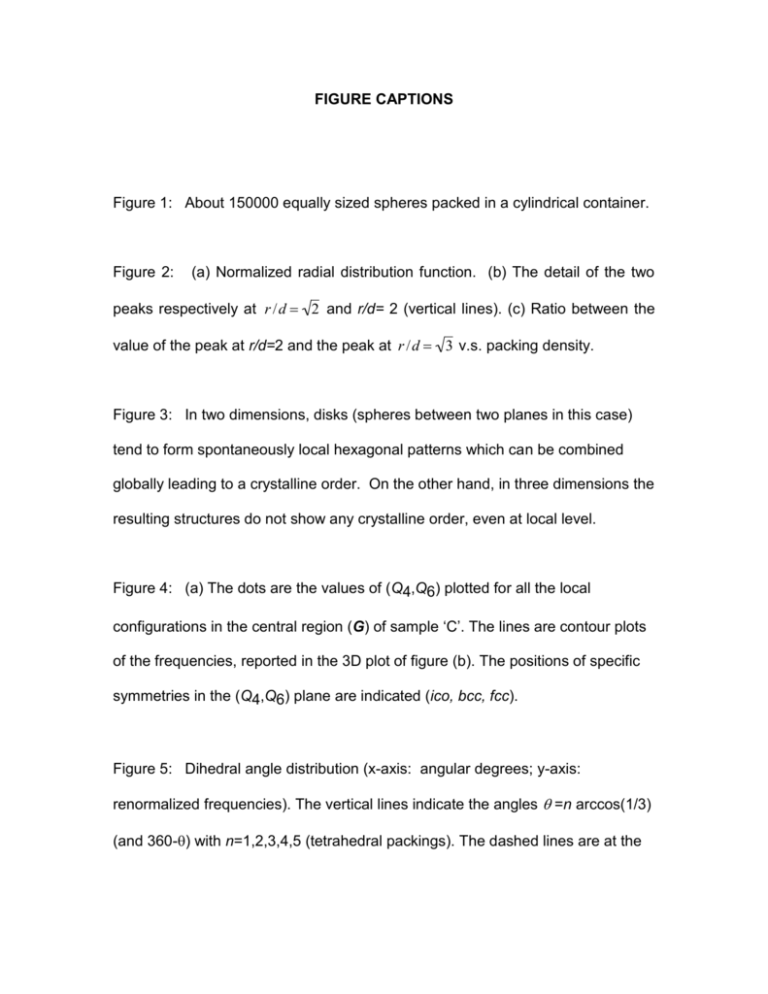
FIGURE CAPTIONS Figure 1: About 150000 equally sized spheres packed in a cylindrical container. Figure 2: (a) Normalized radial distribution function. (b) The detail of the two peaks respectively at r /d 2 and r/d= 2 (vertical lines). (c) Ratio between the value of the peak at r/d=2 and the peak at r /d 3 v.s. packing density. (spheres between two planes in this case) Figure 3: In two dimensions, disks tend to form spontaneously local hexagonal patterns which can be combined globally leading to a crystalline order. On the other hand, in three dimensions the resulting structures do not show any crystalline order, even at local level. Figure 4: (a) The dots are the values of (Q4,Q6) plotted for all the local configurations in the central region (G) of sample ‘C’. The lines are contour plots of the frequencies, reported in the 3D plot of figure (b). The positions of specific symmetries in the (Q4,Q6) plane are indicated (ico, bcc, fcc). Figure 5: Dihedral angle distribution (x-axis: angular degrees; y-axis: renormalized frequencies). The vertical lines indicate the angles =n arccos(1/3) (and 360-) with n=1,2,3,4,5 (tetrahedral packings). The dashed lines are at the angles n 360 (n=1,2,3,4), which will correspond to icosahedral 5 configurations. Figure 6: (a) Distribution of Delaunay volumes in G. (b) The inverse normalized cumulants show tails that decrease linearly in semi-logarithmic scale: p(v exp(- v/d3) (best-fits: =43.9; 45.4; 55.2; 64.6; 66.8; 72.9). Figure 7: Distribution of the number of near neighbors at radial distances within 1.05 diameters. The tick line is the theoretical behavior predicted by a freevolume like local theory: p(n) (4 4 n /n* )n with n*=12.99 (see Eq.4 in Aste 2005). Figure 8: (symbols) Average number of sphere centers within a radial distance r. (lines) Complementary error function, normalized to nc by best-fitting the agreement with the data in the region r/d <1. The averages (r=d) and the standard deviations are calculated from the probability distribution for radial distances smaller than d between pair of centers. The re-normalized complementary error function fits well the data for r/d<1. After this value nearneighbors not in contact start to contribute significantly to nt(r) and the two behaviors split. The ‘deconvoluted’ plots show the differences between nt(r) and the fits with the complementary error functions normalized to nc. Data from (Aste, Saadatfar & Senden, 2005). Figure 9: Number of neighbors in contact v.s. sample density. The filled symbols correspond to the samples investigated in the present work. The two symbols ‘+’ are the values from Bernal (1960) whereas the ‘X’ is from Scott (1962) and Mason (1968). Figure 10: Same as Fig.1 (with a piece removed) where the topological distances from a given central sphere is highlighted in different gray tones. Figure 11: Shell occupation numbers vs. topological distance. The symbols indicate the different samples (as in Fig.8) and the lines are the best-fits using the polynomial form: Kj=aj2+c1j+c0. The fits are between j=2 and j= ˆj = 10 (for samples B, D, E, F ) and ˆj = 15 (for samples A, C). The data refer to threshold distance 1.05d. Figure 12: The coefficient a, plotted as a function of the average coordination number of the contact network (n), shows that disordered packings have larger topological densities in comparison with lattice sphere packings. Figure 13: Total number of sphere centers in a cluster made by all the spheres with centers within a given radial distance r from a given sphere. The thick lines are the average cluster sizes in (G) for samples A-F. The thin lines are the clusters with maximum/minimum number of spheres at a given distance. The filled area is bounded at the top by the most efficient (largest numbers of spheres) packings among the Mackay Icosahedron (Mkly) and the lattices fcc, hcp, bcc, sc. Figure 14: Log-log plot of the average number of sphere centers within a radial distance r from a given sphere for the 6 samples (symbols). The full lines are number of sphere centers within a radial distance r from a given sphere for the Mackay Icosahedron (Mkly) and the lattices fcc, hcp, bcc, sc. Figure 15: Average Isoperimetric Quotients (36(Volume)2/(Surface Area)3) v.s. number of particles in the clusters formed by all the spheres within a radial distance from a given central sphere. The empty square symbols correspond to ordered and crystalline packings (Mkly, fcc, bcc, hcp, bcc, sc).



